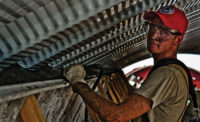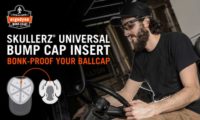Put those two stats together and you get one very large sum.
Most importantly, head injuries can have devastating, life-threatening consequences for workers and their families.
This article, however, aims to address injuries not necessarily accounted for in the above statistics — the countless bumps, cuts, scrapes and bruises that might not require a hospital visit but still are recordable injuries. Without question, these injuries impact worker productivity, effectiveness and comfort.
Head protection history
Since the invention of the modern hard hat in the early 1900s, companies have sought personal protective equipment (PPE) solutions to help prevent head injuries. Hard hats, with their thick plastic construction and internal suspension, are designed specifically to reduce the effects of object-generated impact such as something falling from overhead and hitting the worker.
In applications where these hazards exist, hard hats are often required PPE. Hard hats are not typically required, however, in applications such as aircraft manufacturing and maintenance; heavy equipment and machinery assembly; food and beverage; brewing; HVAC and electrical work; installation and other jobs where structures overhead pose a threat for workers to “bump” their heads.
While providing the utmost in protection, hard hats are not without their drawbacks. In order to protect from object-generated impact and to pass tests per national standards, they are required to be thick and heavy. Hard hats often do not breathe well nor are they particularly comfortable. They also are substantially larger than the wearer’s head, making them awkward to navigate tight spaces in.
When a hard hat won’t work
Clearly an opportunity exists for a protective product designed to prevent cranial bumps, cuts, scrapes and bruises caused by the worker initiating the impact with an overhead hazard that also allows them to safely, effectively and comfortably perform their job tasks. For applications where hard hats are not required or appropriate but protection is still desired or required, workers should wear a bump cap.
A bump cap has a hard shell yet is often thinner than a traditional hard hat. Bump caps typically do not have a suspension system and are not required to conform to the same specifications of ANSI, EN or other global hard hat standards. A bump cap may be as simple in design as a stand-alone plastic shell that looks like a “mini-hard hat,” though these unsophisticated attempts are often uncomfortable, do not breathe, and look oddly out of place.
Bump cap innovations
More recently, bump caps have become available that feature innovative, technical protective shells that are designed to protect workers while keeping comfort and wear-ability issues in mind. These shells are then paired with a fabric cover (simply stated: a hat) designed to work in tandem with the shell to create a product that not only protects workers but one that they feel good wearing.
Caps may come in multiple brim lengths, from a traditional baseball style brim to a short “micro-brim” for very tight spaces. Currently there is no standard for the design and performance of bump caps in the U.S. Europe, however, does provide a standard that allows workers to ensure their bump cap provides a baseline level of both coverage and impact protection. EN 812: 2012 provides both design criteria and impact requirements; testing must be performed at an accredited laboratory. These labs will then issue the cap’s manufacturer a certificate of compliance following the passing of the test. The cap itself must be marked as EN 812-compliant on a permanent label affixed to the shell, letting the user know that they are wearing a compliant product.
What to wear (and what not to wear)
When selecting a bump cap, workers should consider the cap’s protective coverage as well as its functionality, comfort and breathability. Workers are also advised to look for an EN 812-compliant bump cap to ensure the highest quality and level of protection.
Look for a shell that combines full-head coverage with strategically placed vents and air channels in any foam padding that allow for airflow throughout the entire cap. The fabric cover should also be vented to align with the vents in the shell. While many shells are static and do not allow for much adjustment in fit, certain caps “flex” and can be adjusted to fit a wider variety of heads and ensure a secure fit.
To encourage compliance, workers should select a product they feel looks good and professional. Some bump caps can even be embroidered with a company logo and made in a company’s preferred colors to align with a worker uniform.
Use your head
When hard hats aren’t the answer but low ceilings, hanging obstructions, sharp and pointed corners are ever-present obstacles on the job, choose an EN-812-certified bump cap to keep workers safe and productive.



